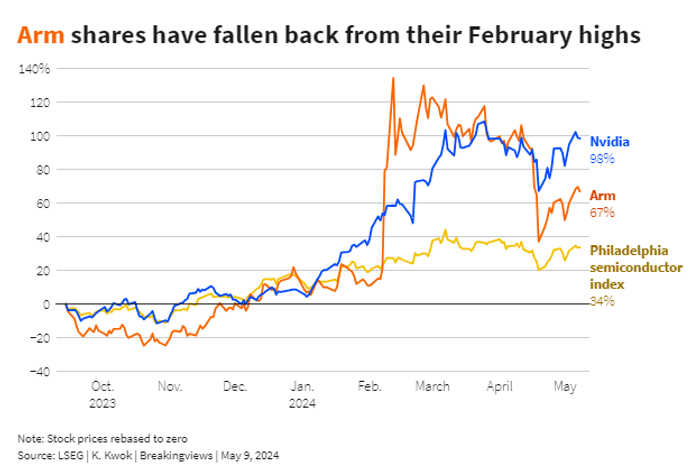Published 18:41 IST, May 9th 2024
Arm encounters the AI bubble’s ups and downs
Building artificial intelligence models and functions requires epic data processing capabilities.
- Republic Business
- 2 min read

Semi-correction. Rene Haas has done a decent job riding the artificial intelligence tiger. The Arm chief executive has seen his shares more than double since overseeing a Nasdaq initial public offering last September. Yet the chip designer’s full-year results, released after market close on Wednesday, are a reminder that AI hype has a downside.
When it listed, the risk with Arm was that it seemed over-reliant on chip design sales to the smartphone market, which faced slowing growth. Its latest results are rather more positive. Fourth-quarter revenue jumped 47% to $928 million and for the year sales grew 21%, beating Arm’s 20% objective. A 44% annual operating profit margin comfortably exceeded Haas’s 40% target. But Arm investors don’t appear impressed: the group’s Frankfurt-listed depositary receipts fell 10% on Thursday morning.
The main culprit is a more conservative outlook. Arm expects 2025 revenue to be between $3.8 billion and $4.1 billion. The $3.95 billion midpoint of this range is very slightly below analysts’ estimate of $3.99 billion as polled by LSEG.
In one sense, Haas is being cautious. Building artificial intelligence models and functions requires epic data processing capabilities, which is fuelling a data centre boom to store and run the information. As they build out the infrastructure the likes of Alphabet’s Google and Amazon are encountering a shortage of an integral component: chips made by AI darling Nvidia. Hence Big Tech is increasingly testing and building their own chips based on Arm’s designs, which helped drive the group’s license revenue up 43% last year to $1.4 billion – 44% of the group total. Arm’s power-efficient chip designs are also getting more useful for energy-consuming AI functions on a smartphone, for example.
Still, Haas has reason not to overpromise. The Nvidia chip shortage means an AI boom cannot materialise overnight – Arm only receives royalty fees for its chips once they are shipped to their customers. Growth in non-smartphone revenue is still relatively in its infancy.
Trouble is, Arm’s share price is a function of AI exuberance and its small free float, which exacerbates swings. In February Arm’s shares doubled in two days on the back of strong third-quarter earnings. While it’s come back down a bit, the group still trades at 70 times the midpoint of Arm’s guided 2025 earnings, compared to Nvidia’s 37 times. When you’re trading at those sorts of levels, even mild disappointments get punished.

Updated 18:41 IST, May 9th 2024